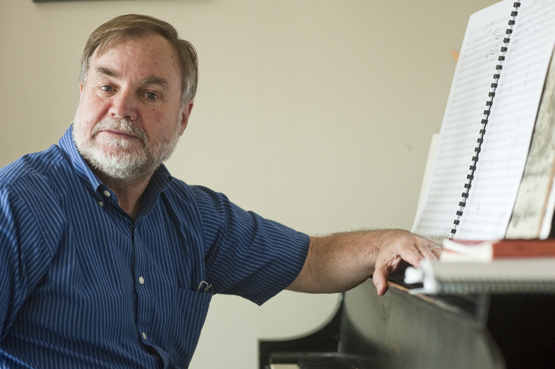Notes on 9/11
Composer Richard Cornell turns poetry into symphonic sound

One cool fall day in 2006, Richard Cornell, a composer with a penchant for computer-mediated music, was making his way around the Web in search of poems that might complement his recent readings of 14th-century Persian poet Hafiz and 20th-century Welsh poet Dylan Thomas. Cornell, a College of Fine Arts associate professor of composition, found downloadable readings of poems about war and listened to a recording of Gary Snyder reading his poem “Falling from a Height, Holding Hands.” What he heard would change his life for the next several months.
 “I heard it,” recalls Cornell, “and I thought, I’m going to have to deal with this.”
“I heard it,” recalls Cornell, “and I thought, I’m going to have to deal with this.”
His way of dealing with the poem would involve five months of imagination, concentration, and labor. He was compelled to transform Snyder’s vision of two people choosing to jump to their death rather than be burned when the World Trade Center was attacked eight years ago. When he was done, 32 words had become 141 bars of symphonic sound written for orchestra and chorus.
Cornell’s composition, called Falling from a Height, Holding Hands, was performed April 28 at Boston’s Symphony Hall by the Boston University Orchestra and the Boston University Symphonic Chorus. Cornell, who has written more than a dozen pieces for orchestra and has collaborated with his wife, Deborah Cornell, a CFA associate professor of art, on virtual reality artworks displayed from Boston to Taipei, says the finished work is very close to what he intended.
He opens the composition with urban texture. There are fragmented phrases from woodwinds. A piccolo and a flute offer up disturbing crescendos, while in the background, low and ominous percussive rumblings can be heard. “It’s what you might hear in a city,” he says, “where sounds come to us over some distance from disparate sources.”
The unease lingers until bar 13, when Cornell brings in the harmonic notes of the contrabass, harp, timpani, tuba, contrabassoon, and bass clarinet.
“For me,” he says, “one of the essential things is the connection between the first line of the poem and the second. The initial question, ‘What was that?’ registers the explosive event. But the second line, ‘A clear day to the far sky,’ is placid and beautiful.”
Cornell says the initial themes were so unnerving that he found it necessary to create a calm before the storm. The tension eases off as he instructs the contrabassoon, trumpets, trombones, and harp to keep the tone tranquil. Then, the chorus erupts with the “What” of “What was that?” (Click on the player below to pause.)
“I set up the entrance of the chorus so that the chorus comes in when the orchestra is not doing very much,” Cornell says. “I wanted to provide the space of a clear articulation of the poem.”
To some extent, he says, his creative options were limited by the need for his audience to understand the words: if vowel sounds are sung in a very high register, they become hard to understand. Elsewhere, he lets it rip.
Cornell, who writes scores in pencil before transferring to his computer, says his music ordinarily does not represent literal events. “But with this piece,” he says, “the emotional reaction is not to the poem, but rather to the events that it recalls.”
Snyder doesn’t dwell on the chaos, but on a personal, internal state at a particular moment. “In my treatment,” Cornell says, “I needed to have both the external turbulence we all remember, as well as the almost calm clarity of that moment of choice.”
He did not write his piece from beginning to end. The choral section, representing that internal voice, came first, providing a heart, which the composer could move toward and away from. “I found out a long time ago that by the time an idea has gotten to the point where I can write it down, it has a lot of history behind it,” he says. “It has to kind of bubble up to the surface.”
And all that bubbles up does not remain. Cornell threw away four endings and about 30 percent more than what appears in the final piece. “I just felt that the rest wasn’t contributing to the argument,” he says.
But the argument isn’t over. Cornell plans at least two more compositions inspired by “Falling from a Height, Holding Hands.”
“There are pieces that you want to write, and there are pieces that you have to write,” he says. “Falling from a Height, Holding Hands was a piece I had to write — it didn’t give me any choice.”
Get the Flash Player to see this media.
Click below to listen to the specific sections composer Richard Cornell focuses on in four short sections of Falling from a Height, Holding Hands.The last is Gary Snyder reading his poem, courtesy of the Poetry Foundation
|
|
|
|
|
|
Kimberly Cornuelle can be reached at kcornuel@bu.edu.
Comments & Discussion
Boston University moderates comments to facilitate an informed, substantive, civil conversation. Abusive, profane, self-promotional, misleading, incoherent or off-topic comments will be rejected. Moderators are staffed during regular business hours (EST) and can only accept comments written in English. Statistics or facts must include a citation or a link to the citation.